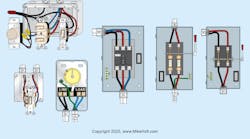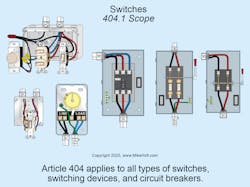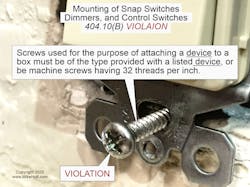The requirements of Art. 404 apply to all types of switches including snap (toggle) switches, dimmer switches, fan switches, knife switches, circuit breakers, occupancy sensors, and automatic switches, such as time clocks and timers [Sec. 401.1] (Fig. 1).
Switch connections
When wiring 3-way or 4-way switches, only the phase conductors can be switched [Sec. 404.2(A) and (B)]. As a conductor for switching purposes (switch leg), you can use a permanently reidentified white conductor within a cable [Sec. 200.7(C)(1)].
Switches controlling line-to-neutral lighting loads must have a neutral conductor installed at all switches serving bathroom areas, hallways, stairways, and habitable rooms or occupiable spaces as defined in the building code [Sec. 404.2(C)]. Where 3-way and 4-way switches are visible in a room, only one of the switches requires a neutral conductor.
You don’t have to install a neutral conductor at lighting switch locations under any of the following conditions:
(1) Where conductors enter the box enclosing the switch through a raceway with enough cross-sectional area to accommodate a neutral conductor.
(2) Where the box enclosing a switch can be accessed to add or replace a cable without damaging the building finish.
(3) Where snap switches with integral enclosures comply with Sec. 300.15(E).
(4) Where the lighting is controlled by automatic means.
(5) Where switches control receptacles.
A neutral conductor must be installed for any replacement switch that requires line-to-neutral voltage [Sec. 404.22] to operate the electronics of the switch in the standby mode.
Exception: A neutral conductor is not required for replacement switches installed in locations wired prior to the adoption of Sec. 404.2(C) where the neutral conductor cannot be extended without removing finish materials. The number of electronic lighting control switches without a neutral conductor on a branch circuit cannot exceed five, and the number of switches connected to any feeder cannot exceed 25.
Switch enclosures
Switches and circuit breakers must be mounted in an enclosure listed for the intended use [Sec. 404.3(A)].
Switch or circuit-breaker enclosures can contain splices and taps if the conductors, splices, and/or taps do not fill the wiring space at any cross-section to more than 75%. Switch or circuit-breaker enclosures can have conductors feed through them if the wiring does not fill the wiring space at any cross section to more than 40% per Sec. 312.8 [Sec. 404.3(B)].
Any surface-mounted switch or circuit breaker in a damp or wet location must be installed in a weatherproof enclosure [Sec. 404.4(A)]. A flush-mounted switch or circuit breaker in a damp or wet location must have a weatherproof cover [Sec. 404.4(B)].
Switches must not be installed within tub or shower spaces unless installed as part of a listed tub or shower assembly [Sec. 404.4(C)].
Indicating
This is typically accomplished by marking on the toggle of the switch itself or by indicative labeling. If you find a switch not so marked, chances are it is a 3-way or 4-way switch, which can be on or off in either the up or down position.
When the switch is operated vertically, install it so the “up” position is the “on” position [Sec. 240.81].
Exception No. 1: Double-throw switches, such as 3-way and 4-way switches, are not required to be marked “on” or “off.”
Accessibility and grouping
Exception No. 1: On busways, fusible switches and circuit breakers can be located at the same level as the busway where suitable means is provided to operate the handle of the device from the floor.
Exception No. 2: Switches and circuit breakers can be mounted above 6 ft 7 in. if they are next to the equipment they supply and accessible by portable means.
General-use snap switches, dimmers, and control switches
The metal mounting yokes for switches, dimmers, and control switches/metal faceplates must be connected to the circuit equipment grounding conductor [Sec. 409(B)]. Use one of these methods:
(1) Metal boxes. The switch yoke is secured with metal screws to a metal box or a metal cover that is connected to an equipment grounding conductor [Sec. 250.109]. The metal faceplate is secured with metal screws to a switch that is connected to an equipment grounding conductor [Sec. 250.109].
(2) Nonmetallic boxes. The switch yoke must be connected to the circuit equipment grounding conductor. The metal faceplate is secured with metal screws to a switch that is connected to an equipment grounding conductor [Sec. 250.109].
Exception No. 1: Where no means exists within the box for bonding to an equipment grounding conductor — or if the wiring method at the existing switch does not contain an equipment grounding conductor — a switch without such a connection to the equipment grounding conductor is permitted for replacement purposes only. A switch installed under this exception must have a faceplate that is nonmetallic and noncombustible with nonmetallic screws, or the replacement switch must be GFCI protected.
Exception No. 2: Listed assemblies are not required to be bonded to an equipment grounding conductor if all the following conditions are met:
(1) The device has a nonmetallic faceplate and the device is designed such that no metallic faceplate replaces the one provided,
(2) The device does not have a mounting means to accept other configurations of faceplates,
(3) The device is equipped with a nonmetallic yoke, and
(4) All parts of the device that are accessible after the faceplate is installed are manufactured of nonmetallic material.
Exception No. 3: An equipment grounding conductor is not required for a snap switch with an integral nonmetallic enclosure complying with Sec. 300.15(E).
General-use snap switches, dimmers, and control switches mounted in boxes that are set back from the finished surface must be installed so the extension plaster ears are seated against the surface [Sec. 404.10(B)].
Screws used for the purpose of attaching a device to a box must be of the type provided with a listed device or be machine screws having 32 threads per inch or part of listed assemblies or systems, per the manufacturer’s instructions (Fig. 2).
In walls or ceilings of noncombustible material (such as drywall) boxes are not permitted to be set back more than ¼ in. from the finished surface. In combustible walls or ceilings, boxes must be flush with, or project slightly from, the finished surface [Sec. 314.20]. There must not be any gaps more than 1⁄8 in. at the edge of the box [Sec. 314.21].
Snap switch rating and use
General-use dimmer switches can control only permanently installed incandescent luminaires unless listed for control of other loads [Sec. 404.14(E)].
Other electronic control switches, such as timing switches and occupancy sensors, can control only permanently connected loads. Use these only for loads that do not exceed their ampere rating at the voltage applied.
Key takeaways
- Use the correct switch for the application.
- Install per the NEC requirements for that switch in that application.
- Install with good workmanship.
This last point includes such things as not having big gaps around a panel or wall mounted switch, mounting it straight, and mounting it right side up. Always ask, “Did I do a professional-looking job?” If not, it probably doesn’t meet Code.
These materials are provided by Mike Holt Enterprises in Leesburg, Fla. To view Code training materials offered by this company, visit www.mikeholt.com/code.







